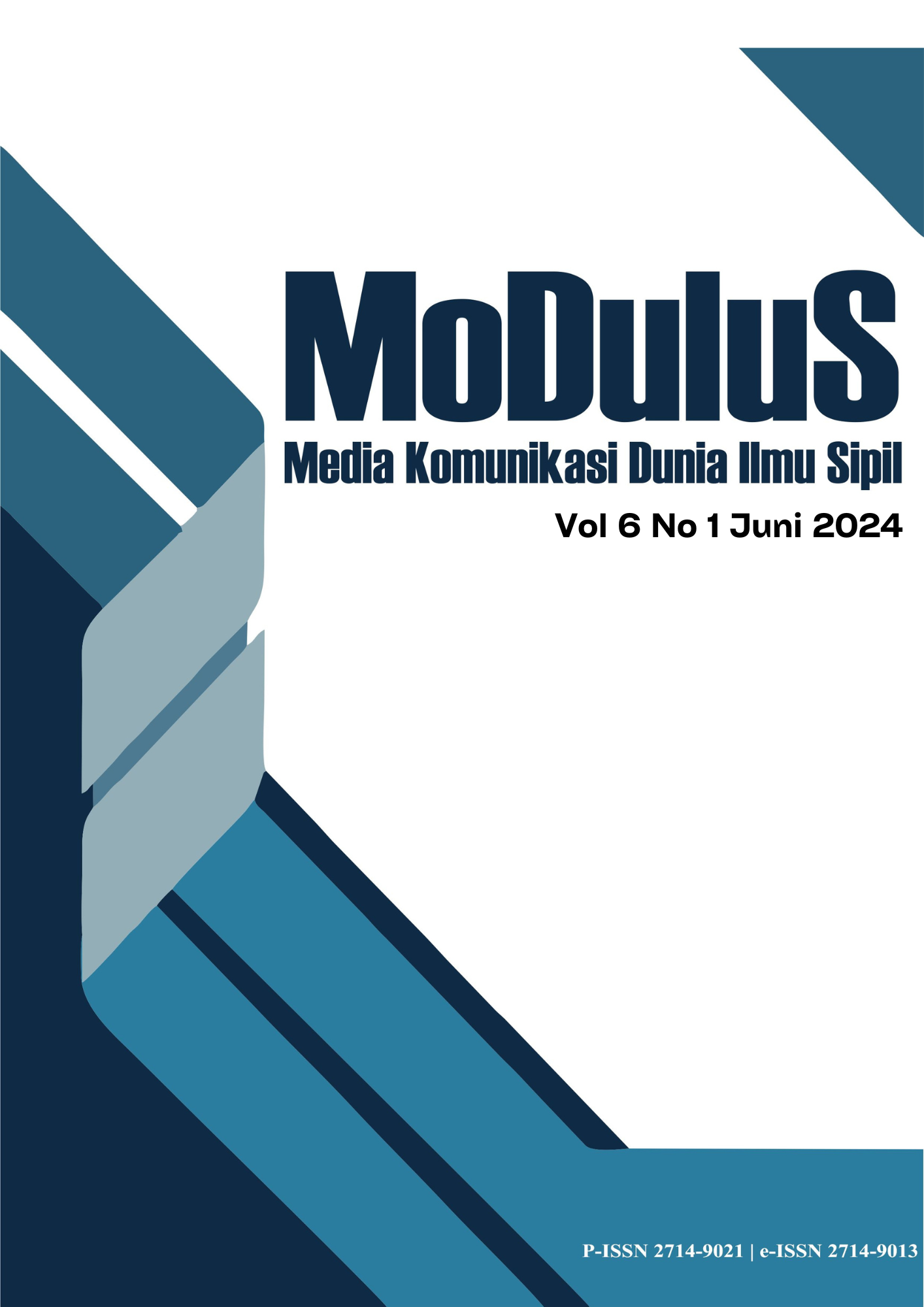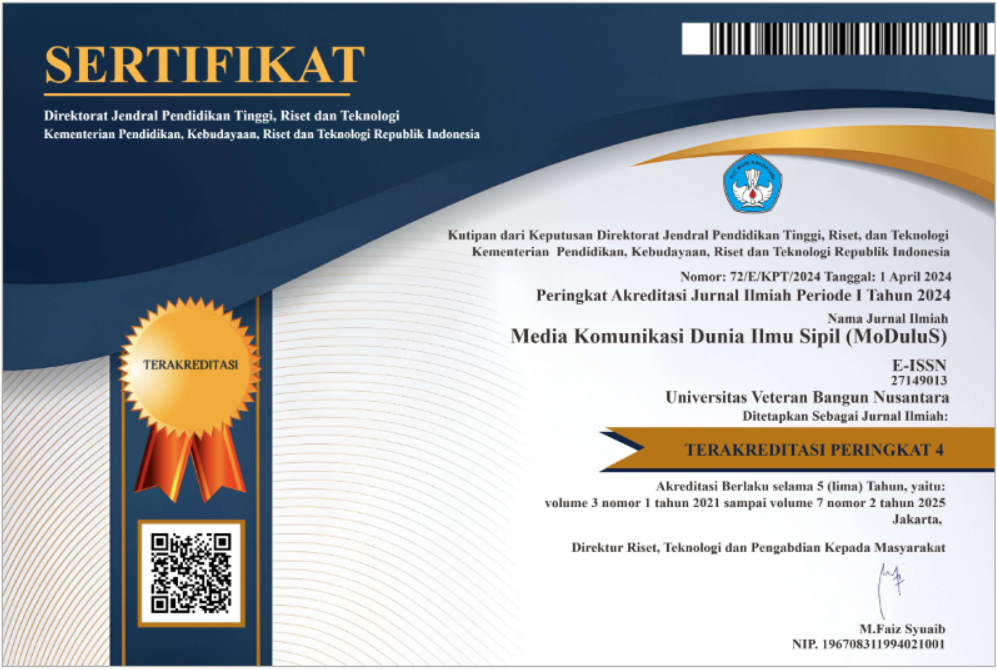Aplikasi Machine Learning Method pada Pemetaan Kerawanan Tanah Longsor di Kabupaten Karanganyar
DOI:
https://doi.org/10.32585/modulus.v6i1.4490Keywords:
longsor, machine learning, Voting ClassifierAbstract
Indonesia berada dalam zona iklim tropis yang rawan untuk mengalami bencana hidrometeorologi. Pemetaan kerawanan longsor merupakan salah satu upaya mitigasi yang dapat dilakukan untuk mengurangi dampak dari bencana tanah longsor. Penelitian ini bertujuan untuk membuat peta kerawanan longsor wilayah Kabupaten Karanganyar menggunakan machine learning yang diklasifikasikan menjadi lima kelas yaitu sangat rendah, rendah, sedang, tinggi, dan sangat tinggi. Metode yang digunakan untuk pembuatan model adalah Voting Classifier Ensemble Technique. Sembilan faktor pengondisi yang digunakan yaitu jarak terhadap jalan sekunder dan tersier, slope, TWI, elevasi, land use, litologi, NDVI, serta curah hujan. Algoritma machine learning didapatkan dari modul Scikit Learn. Kombinasi parameter yang digunakan yaitu pada metode Random Forest menggunakan parameter random_state = 0, n_estimators = 750, criterion = 'entropy', metode Support Vector Machine menggunakan parameter random_state = 0, Probability = True, gamma = 0.005, C = 1, metode K-Nearest Neighbors menggunakan parameter n_neighbors = 11, weights = 'distance', leaf_size = 20, dan metode Voting Classifier menggunakan parameter voting = 'soft', weights = [1,1,1] untuk parameter lain yang digunakan diatur sesuai dengan default modul. Model yang didapatkan memiliki AUC sebesar 0,9563 yang mendekati 1 sehingga dapat dikatakan bahwa model yang dimiliki performa yang baik untuk melakukan prediksi probabilitas longsor.
Downloads
References
Achour, Y., & Pourghasemi, H. R. (2020). How do machine learning techniques help in increasing accuracy of landslide susceptibility maps? Geoscience Frontiers, 11(3), 871–883. https://doi.org/10.1016/j.gsf.2019.10.001
Akinci, H. (2022). Assessment of rainfall-induced landslide susceptibility in Artvin, Turkey using machine learning techniques. Journal of African Earth Sciences, 191(April), 104535. https://doi.org/10.1016/j.jafrearsci.2022.104535
Benbouras, M. A. (2022). Hybrid meta-heuristic machine learning methods applied to landslide susceptibility mapping in the Sahel-Algiers. International Journal of Sediment Research, 37(5), 601–618. https://doi.org/10.1016/j.ijsrc.2022.04.003
BNPB. (n.d.). Geoportal Data Bencana Indonesia. Diambil 9 Maret 2023, dari https://gis.bnpb.go.id/
Bragagnolo, L., Silva, R. V. d., & Grzybowski, J. M. V. (2020). Artificial neural network ensembles applied to the mapping of landslide susceptibility. Catena, 184(September 2019), 104240. https://doi.org/10.1016/j.catena.2019.104240
CDC. (2023). Jenks natural breaks classification method - Health, United States. https://www.cdc.gov/nchs/hus/sources-definitions/jenks-natural-breaks.htm
esri. (2023). Data classification methods—ArcGIS Pro | Documentation. https://pro.arcgis.com/en/pro-app/latest/help/mapping/layer-properties/data-classification-methods.htm
Fitria, I. (2021). Elimination Of Factors In Landslide Vulnerability Risk Mapping Model Based On Artificial Intelligence System.
Hammad Khaliq, A., Basharat, M., Talha Riaz, M., Tayyib Riaz, M., Wani, S., Al-Ansari, N., Ba Le, L., & Thi Thuy Linh, N. (2023). Spatiotemporal landslide susceptibility mapping using machine learning models: A case study from district Hattian Bala, NW Himalaya, Pakistan. Ain Shams Engineering Journal, 14(3), 101907. https://doi.org/10.1016/j.asej.2022.101907
Hoarau, A., Martin, A., Dubois, J. C., & Le Gall, Y. (2023). Evidential Random Forests. Expert Systems with Applications, 230(May), 120652. https://doi.org/10.1016/j.eswa.2023.120652
Khan, M. A., Iqbal, N., Imran, Jamil, H., & Kim, D. H. (2023). An optimized ensemble prediction model using AutoML based on soft voting classifier for network intrusion detection. Journal of Network and Computer Applications, 212(November 2022), 103560. https://doi.org/10.1016/j.jnca.2022.103560
Marzuki, T. (2021). REVISI Skripsi Thoriq Marzuki (30092021). Universitas Sebelas Maret.
Meinhardt, M., Fink, M., & Tünschel, H. (2015). Landslide susceptibility analysis in central Vietnam based on an incomplete landslide inventory: Comparison of a new method to calculate weighting factors by means of bivariate statistics. Geomorphology, 234, 80–97. https://doi.org/10.1016/j.geomorph.2014.12.042
Merghadi, A., Yunus, A. P., Dou, J., Whiteley, J., ThaiPham, B., Bui, D. T., Avtar, R., & Abderrahmane, B. (2020). Machine learning methods for landslide susceptibility studies: A comparative overview of algorithm performance. Earth-Science Reviews, 207(September 2019), 103225. https://doi.org/10.1016/j.earscirev.2020.103225
Naji, M. A., Filali, S. El, Bouhlal, M., Benlahmar, E. H., Abdelouhahid, R. A., & Debauche, O. (2021). Breast Cancer Prediction and Diagnosis through a New Approach based on Majority Voting Ensemble Classifier. Procedia Computer Science, 191, 481–486. https://doi.org/10.1016/j.procs.2021.07.061
NASA. (2013). Earthdata Search | Earthdata Search. https://search.earthdata.nasa.gov/search
NASA. (2020). GES DISC. https://disc.gsfc.nasa.gov/
NASA. (2022). MODIS Web. https://modis.gsfc.nasa.gov/
Pham, B. T., Tien Bui, D., Prakash, I., & Dholakia, M. B. (2017). Hybrid integration of Multilayer Perceptron Neural Networks and machine learning ensembles for landslide susceptibility assessment at Himalayan area (India) using GIS. Catena, 149, 52–63. https://doi.org/10.1016/j.catena.2016.09.007
Priyono, K. D., Jumadi, Saputra, A., & Fikriyah, V. N. (2020). Risk analysis of landslide impacts on settlements in Karanganyar, Central Java, Indonesia. International Journal of GEOMATE, 19(73), 100–107. https://doi.org/10.21660/2020.73.34128
PT. Indonesia Geospasial Tech. (2020). √ Download Shapefile Geologi Seluruh Indonesia - INDONESIA GEOSPASIAL. https://www.indonesia-geospasial.com/2020/03/download-data-shapefile-shp-geologi-se.html
Rai, N., Kaushik, N., Kumar, D., Raj, C., & Ali, A. (2022). Mortality prediction of COVID-19 patients using soft voting classifier. International Journal of Cognitive Computing in Engineering, 3(September), 172–179. https://doi.org/10.1016/j.ijcce.2022.09.001
Sameen, M. I., Pradhan, B., Bui, D. T., & Alamri, A. M. (2020). Systematic sample subdividing strategy for training landslide susceptibility models. Catena, 187(October 2019), 104358. https://doi.org/10.1016/j.catena.2019.104358
Scikit-learn. (2023). 1.11. Ensemble methods — scikit-learn 1.2.2 documentation. https://scikit-learn.org/stable/modules/ensemble.html
Yang, C., Liu, L. L., Huang, F., Huang, L., & Wang, X. M. (2022). Machine learning-based landslide susceptibility assessment with optimized ratio of landslide to non-landslide samples. Gondwana Research, xxxx. https://doi.org/10.1016/j.gr.2022.05.012
Youssef, A. M., & Pourghasemi, H. R. (2021). Landslide susceptibility mapping using machine learning algorithms and comparison of their performance at Abha Basin, Asir Region, Saudi Arabia. Geoscience Frontiers, 12(2), 639–655. https://doi.org/10.1016/j.gsf.2020.05.010
Zhao, S., Dai, F., Deng, J., Wen, H., Li, H., & Chen, F. (2023). Insights into landslide development and susceptibility in extremely complex alpine geoenvironments along the western Sichuan–Tibet Engineering Corridor, China. Catena, 227(24), 107105. https://doi.org/10.1016/j.catena.2023.107105
Zhou, X., Wen, H., Zhang, Y., Xu, J., & Zhang, W. (2021). Landslide susceptibility mapping using hybrid random forest with GeoDetector and RFE for factor optimization. Geoscience Frontiers, 12(5), 101211. https://doi.org/10.1016/j.gsf.2021.101211
Downloads
Published
Issue
Section
License
Copyright (c) 2024 Nada Hanifah Putri, Raden Harya Dananjaya, Niken Silmi Surjandari

This work is licensed under a Creative Commons Attribution-NonCommercial-ShareAlike 4.0 International License.
This work is licensed under a Creative Commons Attribution-NonCommercial 4.0 International License.
















